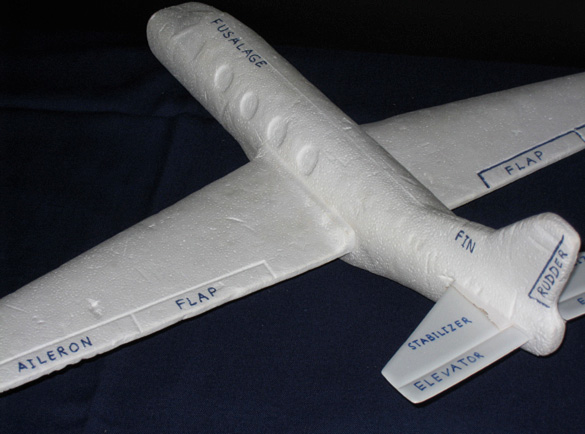
Level: Elementary to Middle School
Time involvement: 10-20 minutes.
To teach some basics about airplanes nothing beats a model of a plane with names of the parts written on it. Nobody needs the name “wing” to know what it is but other parts are less understood. A little background first. Many airplane terms evolved from the historic predecessor of airplanes: ships. Ships have gender: “She sails well”, airplanes; not so much. Ships sailed the seas, airplanes sailed the skies. In rough seas ships would “roll, pitch, and yaw”. So we use exactly the same terms for airplanes in flight. Ships operated in two dimensions, mostly. If seas became rough the flat ocean could develop hills and valleys necessitating the term pitch which described the motion of the bow (front) of the ship lifting or dropping significantly higher or lower than the back (stern).
Ships were steered with a rudder, airplanes too have a rudder (but it is used differently). Ships have captains and their first officers. Airliners use exactly the same terms today! In smaller planes the terms pilot and co-pilot are the accepted terms. Some terms, aileron, for example, are of French origin meaning “little wing”. Fuselage, also of French origin, meant “spindle shape”, applied to airplanes it means the body, or part where the pilot and passenger ride.
Discussion: Airplanes have special parts not found on vehicles or ships. Designing a successful airplane confounded the brightest minds for centuries. Early attempts tried to copy the general appearance of a bird. What these early experimenters failed to perceive was that the birds had the ability to make subtle changes to the shape of their wings. Merely creating a flying machine with wings to provide lift was not enough. Gradually the concept of providing a means to balance the location of the lifting force relative to the weight of the passenger became evident and a solution evolved which resembled the tail found on most birds.
The tail, however, was not static. It had to have the ability to provide either an up or down force relative to the large wing. Frequently designers referred to the tail as the “horizontal stabilizer” because that is exactly what it did. Because it was essentially a small independent wing at the end of a lever it had the important job of controlling whether the airplane was going to climb, dive, or fly level.
Again, because early observers were not able to precisely observe how birds moved their tails to maintain balance the early airplane designs had a “fixed” tail. Eventually, a hinged rear portion was created and controlled by the pilot to increase or decrease the lift by the horizontal stabilizer (or “tail”) and thus control whether the craft would climb, dive, or fly level. The movable part of the horizontal stabilizer was given the name “elevator” because it controlled the flight of the craft in the manner that an elevator allows you travel up or down in a building!
It eventually it became obvious that a successful airplane needed stability to prevent unwanted turns left or right. Thus a vertical stabilizer was added with a similar movable part to control the turning or “yawing” of the craft. We have now described all the simplest elements of a very basic airplane. The Wright Brothers airplane had a horizontal stabilizer (mounted ahead of the pilot) and a rudder mounted on the rear of the craft.
Modern aircraft are equipped with two additional movable surfaces on the trailing edge of the wing: ailerons and flaps. Both change the lift characteristics of the wing. Ailerons on the ends of both wings move in opposite directions. When one moves upward, the other moves downward thus causing the aircraft to roll to the left or right and hence to turn. Flaps, on the other hand move only downward and are used mostly to help during takeoffs and landings.
Notes: The forces and interactions of the various flight surfaces are complex. Younger students are usually satisfied with knowing some terms. Older, more curious minds can delve into amazing inventions that make modern aircraft flight efficient and safe.